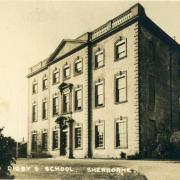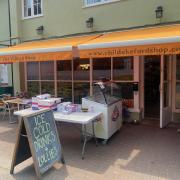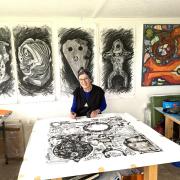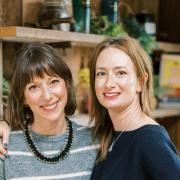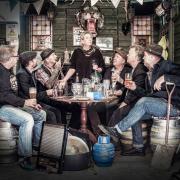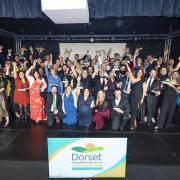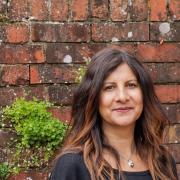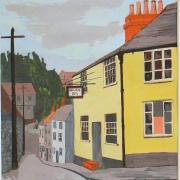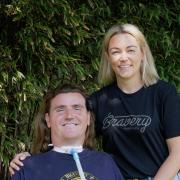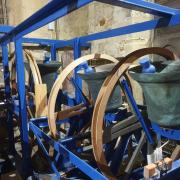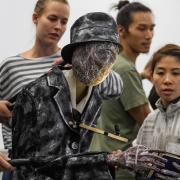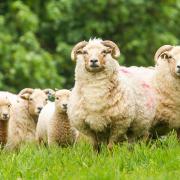3D artist and internet art sensation Darrell Wakelam reveals the inspiration behind his new book which is all about getting creative with recycled cardboard and paper to create something amazing
Art was a huge part of my childhood. I grew up in West Bromwich during the early 1970s, and I was ‘the kid that could draw’. Every classroom has one. I was always making 3D models, often from my own imagination. So, it’s no surprise that I trained as an illustrator. However, in my twenties, I got the chance to work with children and this led me back to the 3D work that I’m now known for; helping children to make models, from recycled household items, that are hopefully better than those I created as a child.

The move to Dorset was also a childhood thing. I was a ‘dinosaur boy’. This led to a passion for natural history and fossils, so I visited the Jurassic Coast many times. Then in 2005, when I wanted to set up my own business, I decided to base myself at Lyme Regis, where you can walk along its fossil strewn beaches.
I visited local schools doing much the same creative art work as I had done in the Midlands, but as well as ‘education’ I got offers of work from all sorts of organisations. One of my favourite projects was creating some pieces for Dorset Museum as part of their ‘Dippy on Tour’ exhibition in 2018. Dippy is the Natural History Museum’s famous Diplodocus skeleton, an exhibit that I’d visited as a boy. So, to be asked to display some of my own artwork, created with children, alongside this legendary dinosaur was incredibly exciting. I also created some 3D artwork for their Geology Gallery. I was invited to the opening along with a hero of mine, Sir David Attenborough. He’d been a massive part of my childhood, so to have the chance to speak to him was a real privilege, and one I will never forget.

Getting creative in lockdown
When the UK went into lockdown in March 2020 my work life came to a total standstill. In the space of two weeks, I lost eight months’ worth of hard-earned contracts as schools realised the scale of what was unfolding. Stuck in limbo, with no income, I had to do something. My skills are all about creativity, making artwork from what you already have around the house. I figured that if I could find a way to share this with others, keep kids stuck at home occupied while getting my work better known, it could earn me ‘future money’. So, I created an online daily art idea for the first 50 days of the lockdown in March/April 2020. I called them ‘Art Jumpstart’ projects sharing them on my Twitter feed @DarrellWakelam with the hope of kick-starting some creativity. Very quickly people started to share the ideas, they sent me photos of what they’d made, and word got around about #ArtJumpstart. My 200 followers on Twitter grew to 15,000 in a matter of weeks and I began to get responses back from further afield. Photos of artwork made by children from the USA, Canada, Australia, Japan, I even had a whole class send me photos of insects they’d made, in Tasmania!
During the second lockdown, that autumn, I built a life-sized cardboard statue of Nelson Mandela in my living room. I shared this on my Twitter feed asking schools to nominate themselves to win the statue. Kelsall Primary School in Cheshire are now the proud owners of my statue. The most incredible part of this project was receiving a message from the Nelson Mandela Foundation in South Africa, thanking me for creating such a positive monument and asking if they could add it to their archive.
Using social media during lockdown was a game changer for me. Prior to this I’d been only an intermittent user, to be honest social media frightened me a little. Through this experience I’ve found new friends and made some amazing connections that otherwise wouldn’t have happened.

Favourite things
When I was devising the initial online projects for #ArtJumpstart, there were over 70 projects posted, I chose ‘tried and tested’ themes that I knew youngsters would engage with: dinosaurs, robots, aliens, birds, animals, insects, rockets, pirates, monsters...my thinking was that if you could get them hooked in by just the subject matter, then you were half-way there.
As to why #ArtJumpstart was so successful, I think it was partly because the kids had to use what was available to them at home. It was also helpful for parents as most of the projects took at least an hour to do, so kept the kids occupied. I also made these projects as printable ‘recipes’, so it got them away from technology for a while and got them using their hands.

By this stage teachers were looking after groups of ‘key worker’ children in schools, these were often different age groups, all working together, so my projects were perfect as they covered a broader age range than maybe a Maths or Literacy lesson could.
By the start of 2021 I was delivering Zoom-based art lessons all over the world and, because of the increased exposure, I got the offer of creating a book to showcase the 3D model techniques I’ve been happily exploring for the last 30 years.

Writing my book
An editor at Bloomsbury publishing, who followed me on Twitter, asked if I would be interested in producing a book based on ideas she’d seen me sharing on social media. After 18 months of making, designing, writing, and editing, Art Shaped, containing 50 sustainable art projects to kickstart children's creativity, is due out on February 16.

The book draws from three distinct sources: themes that proved popular over the many years I’ve been working creatively with children; popular projects on #ArtJumpstart; and finally, I put a shout out to some of the teachers I’d connected with and asked them what would be most useful - such as themes based on the school curriculum or topics they regularly covered.
Art Shaped is aimed at anyone working creatively with children (including parents) and looking for cheap, versatile, adaptable ideas. I want Art Shaped to be like a well-loved ‘recipe’ book, one where the novice can follow the step-by-step instructions, but the more experienced can add their own ingredients and ideas. If kids are given the materials and encouraged to have a go then, in my experience, they will give it a try. Often, they very quickly forget any insecurities and just enjoy the creative and tactile aspect of simply ‘making’. It’s a very human thing, something our ancestors have done for thousands of years. It’s not rocket science, it’s much more exciting than that, because you’re using your imagination to create the rocket!
In terms of my own projects, I’m now back doing face-to-face work in schools and very much in demand. But if I found myself with some time...well I’ve got a real urge to build a life-size ‘terracotta warrior’ out of cardboard. {ENDS}
Art Shaped: 50 sustainable art projects to kickstart children's creativity by Darrell Wakelam is published by Bloomsbury at £19.99. Follow on Twitter @darrellwakelam or visit his website darrellwakelam.com to find downloadable 3D art projects to do at home for free.

Make a 3D Love Heart
To give you a taste of my book Art Shaped, here’s a little making project to create ‘Love Hearts’ for a Valentine surprise or wedding decorations. Use whatever colour combination and romantic phrases you like.
Materials: Scrap cardboard, scissors, masking tape, couple of sheets of tin foil, some tissue paper/kitchen roll, PVA glue, paint.

1 Draw two circles on a piece of scrap cardboard, you could just draw around your tape roll.

2 Cut out some long thin strips of card, these will make the thickness of the sweet.

3 Take one of the thin strips and tape it around the edge of one of the card discs.

4 Fold the other thin strip and attach inside, this will make it stronger.

5 Carefully draw on your romantic wording, then tightly roll up some thin pieces of tin foil.

6 Use the tin foil to make the heart shape and the lettering, fix them on with tape but if it’s too tricky use the glue.

7 Once dry, attach this disc to the top of the other. Tape it securely around the edge being careful not to spoil the letters.

8 Use watered down glue (50/50) to paste on a layer of tissue paper, thin paper, or kitchen roll. Make sure you push this into all of the spaces.

9 Paint the background colour. Once dry, paint the design in a contrasting colour, I used a flat sponge to apply the colour so that it just picks out the raised parts.

10 And here are the finished ‘Love Hearts’
Follow on Twitter @darrellwakelam or visit his website darrellwakelam.com




